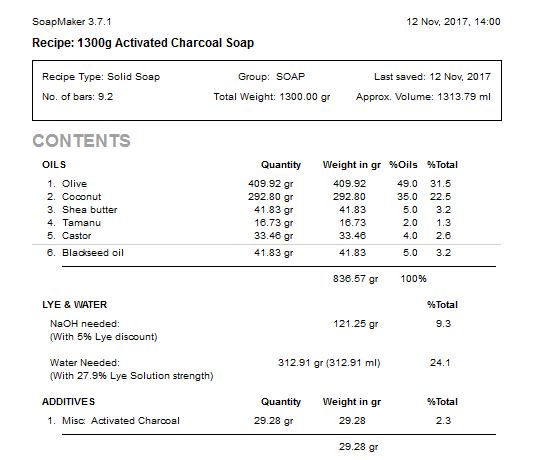Acne Survivors Charcoal Facial Bar
I have heard some great things about activated charcoal soap and recently in our Facebook group people have been discussing the positives and negatives of using high pH cold processed soap for people who have acne or very oily skin. Some people swore by using soap and others felt that due to the pH, which is typically around 9-10, it was not suitable for people who have the occasional spot or more serious acne.
I have never suffered from acne, though I do still get hormonal zits which are in no way as debilitating or painful as having severe acne. Therefore, I can not attest to whether cold processed soap is indeed something that could work for people who live with severe acne. Nevertheless, having taken part in the discussions and having a burning desire to make some soap, I decided to formulate something that might work for people who have acne. This is what I came up with.
The Formulation
I used the Soap Maker program to calculate my lye and oil amounts. Below is a percentage breakdown of the formula.
Method
Measure out your sodium hydroxide and water in separate containers.
Gently pour the sodium hydroxide (NaOH) into the water and stir making sure you avoid any fumes. Always pour the NaOH onto the water (it's very important). The water and NaOH mixture is known as lye.
While the lye is cooling down prepare your oils. Weigh your liquid oils out one by one in a container. Weigh your hard oils or butters and melt them so they are a liquid and add to the other oils.
Add your charcoal or powder extracts to the oil.
When everything is cool add the lye to the soap and mix with a stick blender until it starts to thicken or come to trace.
Pour into your moulds.
Leave for 24-48 hours and then unmould and leave to cure for 4-6 weeks.
N.B - please be safe - wear goggles, gloves, an apron, and make sure you have a long sleeve top to protect you from splashes. Lye is highly corrosive and will burn. You don't want any in your eyes.
Also wear a dust mask. Activated charcoal has a very small particle size and you want to protect your lungs. I like to process when all my ingredients are either cold or tepid in temperature. Some people like to process when everything is warm.
Ignore the charcoal entry in the image. I made 1300g of soap batter, however, after this, I discovered that I only had 5.22g of activated charcoal so decided to test to see how much would be needed to make a black soap. I successfully added 300g of the soap batter to the charcoal, making it 305.22g of soap batter. This is calculated as 1.71% activated charcoal to make a black soap. I would say that you roughly need about 1.7-2g of charcoal to every 100g of soap.
To the remaining 1000g of soap, I added 25g of powdered Blackseed/Nigella sativa.
I used a base of my usual Olive oil, Shea and Coconut oil. To it I added Tamanu Oil and Blackseed oil. Tamanu oil is known as 'oil of the gods'. It has been used to help treat many skin problems including acne scars, stretch marks, sunburn and is supposed to be a good anti ageing oil. It is purported to have anti-bacterial and anti-inflammatory properties so would be good for acne as they are normally inflamed and caused by bacteria; it is particularly recommended for acne. It has a very distinctive scent - I liken it to Helichrysum or Immortelle essential oil - pungent and almost curry-like. When added to soap at 1.3% it changes the soap to a light green colour.
Blackseed or Nigella sativa is known to be a cure-all oil. It has a peppery, almost medicinal smell. It is has been used for millennia by people in the middle east and is taken internally. Studies have found it to be anti-bacterial, with the ability to fight superbugs. Studies have also shown it to be a powerful anti-fungal due to its inherent high levels of thymoquinone and thymol. Other studies have found it to be great for helping with eczema.
Below is a picture of the poured soap. The colour is very deep in the charcoal soap. The lower one, with crushed Nigella seeds, has come out an interesting colour and texture.
DISCLAIMER: ONLY MAKE THIS SOAP IF YOU KNOW THE GENERAL SOAP MAKING PROCEDURE AND HOW TO WORK SAFELY WITH THE INGREDIENTS!!!!!!


